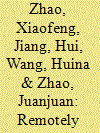|
|
|
Sort Order |
|
|
|
Items / Page
|
|
|
|
|
|
|
| Srl | Item |
| 1 |
ID:
111418


|
|
|
|
|
| Publication |
2012.
|
| Summary/Abstract |
Although concentrating solar power (CSP) technology has been projected as one of the most promising candidates to replace conventional power plants burning fossil fuels, the potential advantages and disadvantages of the CSP technology have not been thoroughly evaluated. To better understand the performance of the CSP technology, this paper presents an ecological accounting framework based on embodied energy and emergy analyses methods. The analyses are performed for the 1.5 MW Dahan solar tower power plant in Beijing, China and different evaluation indices used in the embodied energy and emergy analyses are employed to evaluate the plant performance. Our analysis of the CSP plant are compared with six Italian power plants with different energy sources and an American PV plant, which demonstrates the CSP is the superior technology.
|
|
|
|
|
|
|
|
|
|
|
|
|
|
|
|
| 2 |
ID:
121375


|
|
|
|
|
| Publication |
2013.
|
| Summary/Abstract |
Taking the city of Xiamen, China, as an example, we used thermal infrared remote sensing to detect thermal pollution, and examined its relationship to energy consumption and the industrial economy. Monthly changes in 2002 and dynamics throughout the period of rapid urbanization (1987-2007) are analysed. It is found that seasonal variation led to distinct shapes and sizes of thermal pollution areas, and winter thermal pollution was highly indicative of industrial and energy transformation sources. Industrial enterprises were the dominant sources of winter thermal pollution in Xiamen. The number and ratio of industrial thermal pollution sources increased stably in the earlier years, and dramatically in the later period (2002-2007), attributable to the effects of China entering the World Trade Organization. Linear regression shows that the number of thermal pollution sources was strongly correlated with several factors of the industrial economy and energy consumption, including industrial outputs, industrial enterprise numbers, LPG and electricity. Related mitigation measures are also discussed. This research builds a link between remote sensing-detected thermal pollution information and statistical energy consumption data, as well as industrial economy statistics. It thereby enhances understanding of the relationship between urbanization, industrialization, energy consumption and related environmental effects.
|
|
|
|
|
|
|
|
|
|
|
|
|
|
|
|
|
|
|
|
|